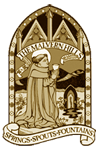Who are Friends?
Friends promote research, conservation and celebration of the Springs, Spouts, Fountains and Holy Wells of the Malvern Hills and of Great Malvern as a
Spa
Town. If you would like any back numbers of our Newsletters send a large SAE to Bruce with details of which ones you require. There is no charge and they may be collectors items one day! The reason why we have been able to distribute Newsletters to Friends without charge in the past is because of the donations from individual Friends and the generosity of the Spas Research Fellowship, which handles our mail. From 2007 however, due to the ever increasing numbers of Friends (now in their hundreds), we have to make a small charge for occasional Newsletters of 5 pounds for 4. This will only apply to renewals and new Friends.
Was Stonehenge a healing centre based on Springs and Wells in
Wales?
Modern scholarship is now reshuffling the stones with the idea that
Stonehenge, with its astronomical alignments, was a place of worship and healing. Professor Timothy Darvill, Head of the Archaeology Group at
Bournemouth
University, has breathed new life into the controversy surrounding the origins of the bluestones that form part of
Stonehenge by announcing a theory which suggests that the ancient monument was a source and centre for healing and not a place for the dead as believed by many previous scholars.
In conjunction with the publication of his new book - Stonehenge: The Biography of a Landscape (2006), Professor Darvill makes a case that the henge was 'occupied' by a prehistoric oracular god - the equivalent of the Roman and Greek god of healing, Apollo - who 'chose' to reside in winter with the ancient Britons.
Professor Darvill says 'Our work has taken us to the
Preseli
Mountains to provide a robust context for the source of the bluestones and to explore various ideas about why those mountains were so special to prehistoric people. It was believed that these particular stones had many healing properties because in Preseli, there are many sacred  springs that are considered to have health-giving qualities; the water comes out of the rocks used to build
Stonehenge.'
springs that are considered to have health-giving qualities; the water comes out of the rocks used to build
Stonehenge.'
Details of his theory on the springs is not however included in his book, but was presented by him as part of the launch programme. Was Stonehenge the
Lourdes of its day, to which diseased and injured ancient Britons flocked seeking cures for their ailments?
Stonehenge was built in different stages between the 4th and 2nd Millennia BC. There is great argument as to whether the bluestones that make
up part of Stonehenge were brought by man from
Wales or were moved as a result of glaciations in the Ice Ages. Do you have a view? Lets us know.
Malvern Water takes on new aura
The fame of our springs and wells is in part due to the international reputation of Malvern Water. Bottled for hundreds of years, there is now only one bottling plant remaining, that at Colwall. Now Malvern Water is to be renamed Malvern, The Original, English Water. The attractive new label is as illustrated. This will doubtless have a significant effect on the international marketing of our local water, identifying Malvern
England as the origin of the famous product. This name change of our local water will also enable advanced technology filtration to be incorporated in the production line, thereby supplementing the natural processes of the bedrock purification. This reflects the ever exacting demands of the consumer. As they say at Colwall 'nothing significant changes, it is still the original water from the same source, has the same mineral content and the same great taste'. We understand that the first consignments were dispatched to a number of famous households in January, perpetuating a loyalty that has been prevalent for many years.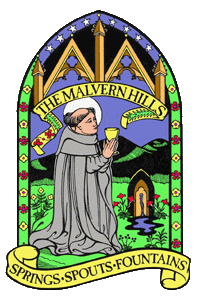
St Werstan's Labyrinth - a proposal
This proposal is for the recreation of an ancient, magical labyrinth in
Rose
Bank
Gardens, Great Malvern. It would act as a place of pilgrimage for those interested in the patron saint of Malvern Springs and Wells. In addition it would provide a visitor attraction for the park, which tends to be something of a backwater, albeit in the centre of Malvern town.
St Werstan was the original martyr saint who established a cell below the present day
St Ann's Well in the 11th century. Murdered by the Celts shortly afterwards, his cell was eventually to lead to the founding of Great Malvern Priory. He is commemorated in the 15th century stained glass windows of the priory church and his life has recently been the subject of scholarly re-examination and publication.
Rose Bank Gardens are significantly placed between Malvern priory church and the terrace where St Werstan founded his cell. Linking the two is the ancient processional way now known as the 99 steps. The steps border the northern end of
Rose
Bank
Gardens. This public park is in the ownership of the local authority and for some time now there have been various proposals to enhance it. The site is a terrace overlooking the town and facing east. This vista is key to the proposal as will be explained.
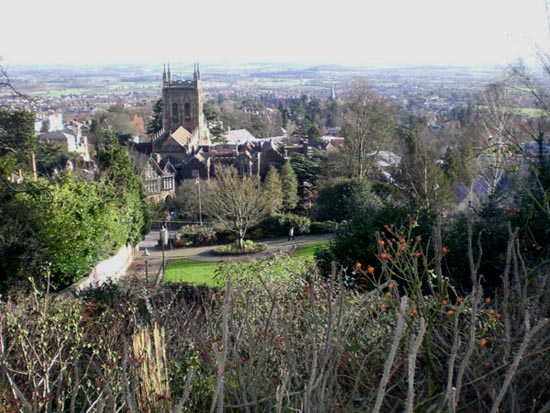
Ancient labyrinths occur in many early cultures and are of great antiquity. In particular the Troia labyrinth is a particular design that can be traced over several millennia back to ancient
Egypt,
Crete,
India, etc. It occurs on a 600 B.C. Etruscan wine jar. It even occurs in the art of the Hopi Indians in
North America. The design is carved into rock near
Tintagel
Castle in
Cornwall and can be found alongside early 18th century graffiti in stone mines in
Surrey. Many of relatively recent origin appear in a variety of locations throughout
Europe and are traditionally associated with festivals, dancing and games. Where they are located near abbeys, they are thought to have a devotional function, providing monks with a secluded path to walk during their meditations.
The origin and meaning of these labyrinths remains a mystery. In ancient
Rome, Virgil describes how Trojan youths performed an annual ceremonial dance, with twists and turns that represented the Cretan Labyrinth. This Troia or
Troy game supposedly created a magical field of exclusive force and was of great spiritual significance. Labyrinths can be thought of as symbolic forms of pilgrimage; people walk the path of life, ascending towards salvation or enlightenment. Many people were unable to travel to holy sites, so the use of labyrinths and prayer substituted that need. Later, the religious significance of labyrinths faded and they were used primarily for entertainment, although recently their spiritual aspect has seen resurgence.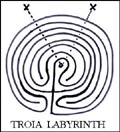
The Proposal is that part of
Rose
Bank
Gardens should be landscaped to incorporate a Troia labyrinth of sufficient size that the pathways would be easily walked. Because of the easterly orientation and elevation of the site it is also suggested that two solar alignments should be included in the landscaping. These would be standing stones or monoliths of Malvern stone that would align to the winter and summer solstices, where the sun rises over the horizon. (c. 50 degrees and 131 degrees azimuth from due north)
* The location would provide a point of pilgrimage for those wishing to explore and understand the legend of St Werstan and his relevance to Malvern. Much about him remains a mystery as does much about the Troia labyrinths. The location in the immediate vicinity of the priory church, Werstan’s cell site and the linking processional way would assist in providing practical understanding of his story.
* The solstice alignments celebrate ancient Celtic belief systems. Such celestial alignments are well known to exist in the ancient stone circles of pre-Roman
Britain. In addition later Christians believed the east to be significant in that it heralded the direction of the coming of the Messiah. For St Werstan it also identified the direction of his former home at Deerhurst monastery to the south-east.
*
Rose
Bank
Gardens as a result would be given a raison d'etre, which it is generally recognised as lacking at the present. Both visitors and local residents would be attracted to the labyrinth for a variety of reasons, historical research, fun and games, especially with children, and festivals and celebrations. For those wishing to explore the springs and wells, the gardens would provide an entry point with access to
St Ann’s Well and beyond.
* The inclusion of a water drinking fountain at the centre of the labyrinth would add a further dimension to the proposal in that it would become a symbolic recreation of St Werstan's Well. It is known that natural water sources existed in the immediate vicinity and St Werstan would have used these for worship and day to day needs. His well however no longer is identifiable and this would symbolically overcome this. It would also provide a goal for walking the labyrinth.
* With a little imagination the labyrinth can be seen to open the door to a wide variety of second generation activities; children's games based on simple marker throwing to see who reaches the centre first or perhaps celebrations of St Werstan's feast day, still to be ascertained.
The question of cost has also been considered. Whilst not necessarily a high cost project there may be possibilities for sponsorship. There is an indication from a substantial local enterprise that assistance with the development of this project may be forthcoming. It does however require a general consensus that such a project is worthwhile as well as the participation of the Local Authority. This proposal seeks to kindle that interest.
Illustrations:
Rose
Bank
Gardens from St Werstans Cell site, showing the level terrace where a Labyrinth might be landscaped. The 99 steps
Processional Way is on the left and the priory is seen beyond.
The Troia labyrinth design
A Troia labyrinth used in landscaping.
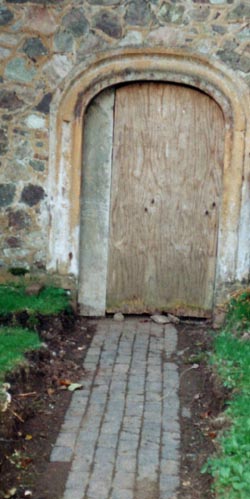 Further reading:
Further reading:
The Illumination of St Werstan the Martyr, Weaver C. Osborne B. (2006)
Cult and Occult, King F (1985)
A number of web sites are informative about labyrinths. In particular that of the Labyrinth Society at www.labyrinthsociety.org Do let us have your views about this proposal.
Water Heritage under Threat?
Last year the local paper announced the discovery of the original path leading from the roadway to the spout at North Malvern Clock Tower. The path dates back to 1836, when the water tank was built by philanthropist Charles Morris for the inhabitants of
North Malvern. The path had for decades been submerged under soil and grass, and when it was revealed the front of the tower more closely resembled 1830s and '40s engravings of the clock tower. A Friend was most concerned therefore when it was discovered that the Heritage Lottery Fund contractors had dug up much of the path. This the HLF at first denied, but later admitted was the truth. The North Malvern Clock Tower is a Grade II listed building under the Malvern Hills District's Department of the Environment list of Buildings of Special Architectural or Historic Interest (May 1979), which was compiled in response to section 54 (1) of the Town and Country Planning Act of 1971. The Act is part of a local and national conservation policy and the digging up of the path should not have happened.
Of our built spa heritage, only Spa Cottage in
Priory Road,
St Ann's Well, Holy Well, and the clock tower, are listed. A register of 37 other water features have been submitted to MHDC for local listing; let's hope the Council can stop the threat to Malvern’s water heritage.
Drop The Dead Donkey?
In 2005 as part of the HLF initiative to restore our springs and wells, water was restored to the cascade at the side of St Ann's Well and the new feature inappropriately named the Old Moses Spout. (see Newsletter 13) Throughout the very dry summer of 2006 sadly not a drop of water issued, and the flow at
St Ann's Well itself was reduced to the merest 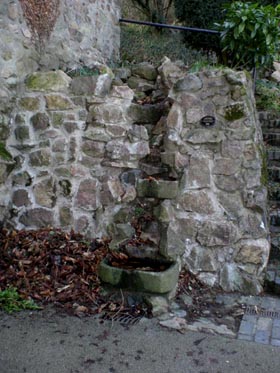 trickle. In mid-January 2007, after copious floods of rain, the spout at
St Ann's Well was gushing amiably. Not so the Old Moses Folly, which remained almost as
dry as a dead donkey’s bone. It seems that our springs, like the donkeys of a bygone era, have a mind of their own and work only when they feel like it - and not always as a result of man's 'encouragement'. Let’s hope that the recalcitrant spring can be brought to order and function properly for this summer so that the many dogs and horses, and even donkeys on the hills can take a welcome drink.
trickle. In mid-January 2007, after copious floods of rain, the spout at
St Ann's Well was gushing amiably. Not so the Old Moses Folly, which remained almost as
dry as a dead donkey’s bone. It seems that our springs, like the donkeys of a bygone era, have a mind of their own and work only when they feel like it - and not always as a result of man's 'encouragement'. Let’s hope that the recalcitrant spring can be brought to order and function properly for this summer so that the many dogs and horses, and even donkeys on the hills can take a welcome drink.
Nomination for St Werstan Award - in conjunction with Malvern English Water
We have had a mixed response to the nomination of
St Ann's Well. We will not therefore be pursuing this nomination further. Thank you to the Friends who returned the ballot papers expressing their views.
Diary Dates
In 2007 the legendary Springs and Wells Coach Tour will take place on Sunday 6th May. The tour will leave Belle Vue Terrace at 2pm. and will last for about 3 hours. Tickets are 4 pounds 50 pence, available from the Tourism Information Centre in Malvern nearer the day. Book this date for a tour of the hills to be remembered.
On July 14 there is a Civic Society coach trip to Buxton, the heritage spa town. This all day trip is being conducted by Bruce and hopefully Cora. Friends are welcome to join the party. The plan is to look at Buxton's springs and wells heritage and the development as a major 19th century spa resort. Note the date; more details will be supplied in forthcoming Newsletters.
Join the Wells and Spas Discussion List - Did you know that there is an email discussion group for Wells and Spas? It is a useful forum for communicating with people of like interest if you have an email facility. It does not cost anything to participate and is an excellent way of exchanging ideas, particularly if you are a scholar of springs or spas. To find out more go to
http://www.jiscmail.ac.uk/cgi-bin/webadmin?A0=wells-and-spas&D=0&H=0&O=T&T=0
The third option on the central menu enables you to join or leave the list.
Email: springs@thespas.co.uk (click here to send an email)



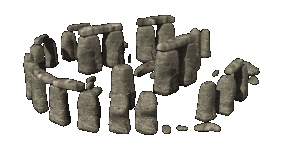
 springs that are considered to have health-giving qualities; the water comes out of the rocks used to build
springs that are considered to have health-giving qualities; the water comes out of the rocks used to build



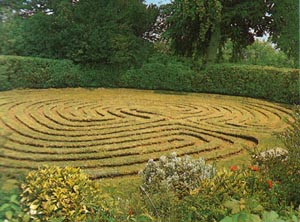
 Further reading:
Further reading:
 trickle. In mid-January 2007, after copious floods of rain, the spout at
trickle. In mid-January 2007, after copious floods of rain, the spout at
 Newsletter Archive which can also be accessed from our WEB SITE INDEX.
Newsletter Archive which can also be accessed from our WEB SITE INDEX.
